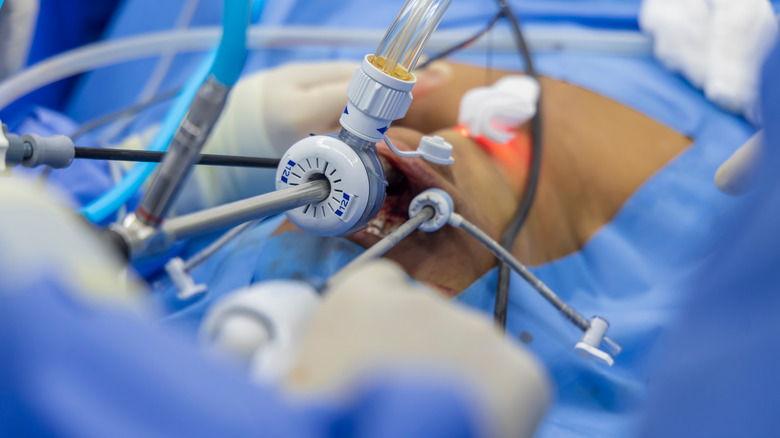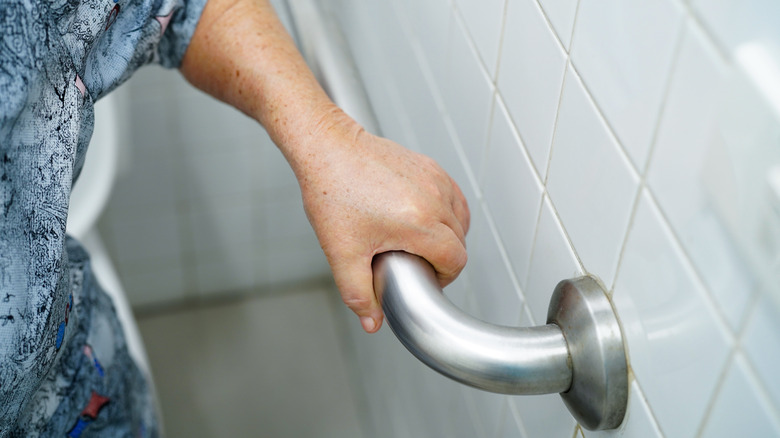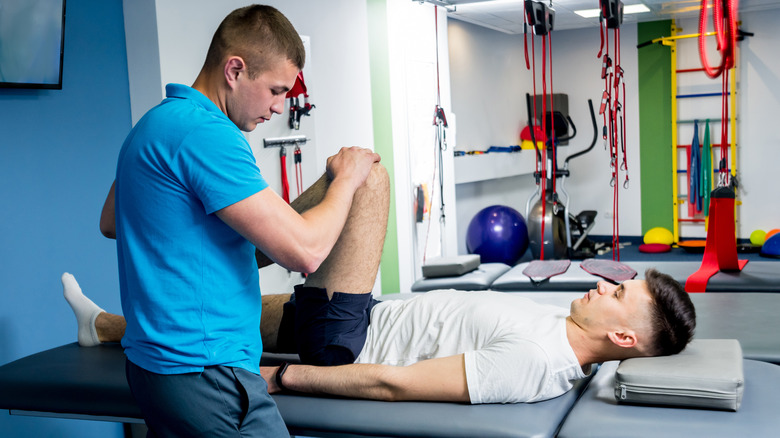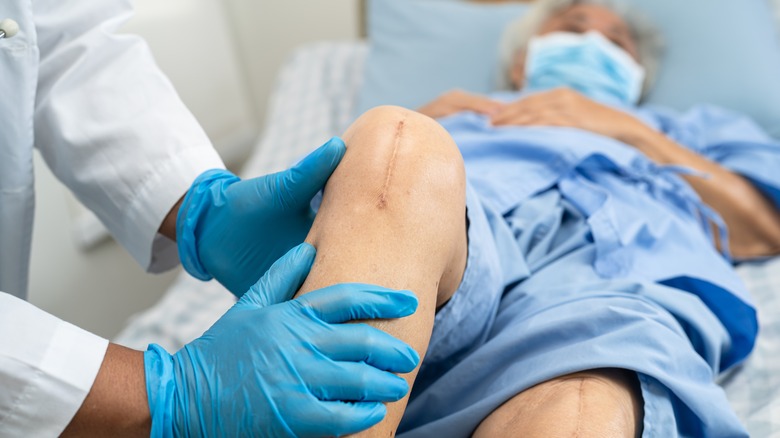Everything You Should Know Before Getting Knee Replacement Surgery
If you're considering knee replacement surgery, also called knee arthroplasty, chances are you've been dealing with a painful knee for quite a while — with discomfort that makes it difficult to go up and down stairs, walk much of any distance, and even sit or lie down comfortably (via the American Academy of Orthopaedic Surgeons). Walking supports and medications aren't helping anymore, and wishful thinking about the pain magically going away hasn't proven effective either.
Possible causes of chronic knee pain include osteoarthritis, which is age-related wear and tear on the knee joint; rheumatoid arthritis, a disease where the synovial membrane around the joint thickens and becomes inflamed; and post-traumatic arthritis, brought on by a serious knee injury.
The first knee replacement surgery was performed in 1968, and today knee replacements are one of the most successful procedures in all of medicine. In 2017, more than 754,000 knee replacements were done in the United States.
Knee replacement surgeries have been successfully performed on people of all ages, from teenagers with juvenile arthritis to older people with degenerative arthritis, so you may be a good candidate for knee replacement surgery, no matter what your age. Decisions are made on a case by case basis. And, while the implants only lasted about a decade in the 1970s, today's implants have a life of about 20 years, according to WebMD.
Before getting your knee replacement surgery, take a look at what we've covered here — the information will be helpful in your journey.
Alternatives to try
If your goal is to postpone knee replacement surgery as long as possible, there are a number of things you can do to help manage your pain and stay active (via HealthPartners).
As counterintuitive as it may seem, exercising and moving your joints, in spite of the pain, can actually stimulate the flow of fluid around your knees, strengthen the muscles that support your knees, reduce stiffness, and increase flexibility. Stick to low-impact activities such as walking, swimming, strength training, and cycling. Any exercise that strengthens your core, hips, and legs, without damaging your knees any further, should help manage your pain.
Working with a physical therapist to get a personalized exercise plan you can do at home can also have long-term benefits — especially if you're consistent about doing the exercises on your own. And if you're even a little overweight, consider losing a few pounds. According to HealthPartners, even losing one pound eliminates four pounds of pressure on your knees, which is pretty impressive.
Cortisone shots and other injections that include hyaluronic acid (HA) help lubricate the inside of the knee and may provide short-term relief — up to about three months — from arthritis pain, says Johns Hopkins Medicine.
As for medications, steer clear of opioids if at all possible; they're addictive, and aren't proven to help long-term knee pain. And check with your doctor even before using over-the-counter drugs like ibuprofen and naproxen because they can have side effects.
The difference between partial and total knee replacements
The knee has three different parts: the inside (medial), the outside (lateral), and the front, between the kneecap and the thigh bone (patellofemoral), explains Southeast Orthopedic Specialists. If only one compartment of your knee is damaged, a partial knee replacement may relieve your pain while leaving the ligaments in the front and back of your knee intact.
A partial knee replacement tends to involve less bone and tissue disruption, less blood loss, and faster and better recovery of your knee's range of motion. On the downside, there's no guarantee that arthritis won't progress to other parts of your knee, requiring a total knee replacement at a later date (via the Hospital for Special Surgery).
Most people don't qualify for a partial knee replacement because two or more compartments of their knee are damaged, notes the American Academy of Orthopaedic Surgeons, and total knee replacement is needed. It involves surgery on your whole knee, removing diseased or damaged parts of the knee joint and replacing them with artificial components that allow your knee to move like a normal, healthy knee (via Southeast Orthopedic Specialists). This comprehensive repair usually lasts longer than a partial knee replacement, and is often the best choice if you have severe osteoarthritis and chronic knee pain.
Minimally invasive knee replacement surgery is an option for some people
Minimally invasive and traditional knee replacement surgeries involve cutting soft tissue and bone to implant prosthetic knee joint components, but one requires a smaller incision and often less cutting of muscles, tendons, and ligaments (via Arthritis-health).
In traditional knee replacement surgery, an 8 to 12 inch incision is made down the middle of your knee; the quadriceps muscles, quad tendon, and other soft tissues are cut; and the kneecap is turned over 180 degrees. Minimally invasive surgery only requires an incision that's 3 to 6 inches long and, while it cuts through some deep soft tissue, certain muscles and tendons are pushed or lifted out of the way instead of being cut. The kneecap is often just pushed aside too.
Candidates for the minimally invasive procedure are often younger, thinner, and healthier than people who have traditional surgery, according to the American Academy of Orthopaedic Surgeons. The approach is less appropriate for people who are overweight or who've had other knee surgeries.
The location of the incision, the shape of the incision, and the way the soft tissue and muscles are moved out of the way for the knee replacement varies in minimally invasive knee replacement. Because this approach gives the surgeon less access to the knee joint, it can be harder to achieve the best prosthetic fit and joint alignment.
Knee replacement surgery does involve some risks
Like most surgeries, knee replacements have a long list of possible risks and complications, starting with side effects of the anesthesia, and the possibility of excess blood loss during the procedure, explains Medical News Today.
Blood clots can occur if a blood vessel is damaged during the surgery, or if you don't move during the days after surgery. And pulmonary embolism, where a blood clot travels to the lungs and blocks the flow of blood, can be life-threatening.
Allergic reactions to the metal components in knee implants occur in some cases, so if you have a history of allergic reactions to metal jewelry, be sure to mention that to your doctor before surgery. Infection is also possible at the surgical site, including redness, warmth, and swelling, along with fever and chills.
In some cases, new joints can get dislocated or become loose (via WedMD), and there's always the risk that your new joint won't perform as well as you'd hoped — especially if you aren't diligent about sticking to your rehabilitation plan.
You are at most risk of blood clots and infections if you "have heart disease, diabetes that's not well controlled, or a weak immune system" — and you may receive antibiotics or blood thinners to help prevent these problems. Most complications of surgery can be treated, and the surgery may still be considered successful if the knee's function improves over time and pain is eliminated, according to Arthritis-health.
Questions you should ask
You may already have a list of questions you want to ask your healthcare team before considering surgery, such as what your other options are, if there's harm in putting off the surgery, if you need a total or partial replacement, and if you're a candidate for minimally invasive surgery (via Mount Sinai).
Once you're committed to going ahead with knee replacement surgery, ask your healthcare team what you can do to maximize the success of the surgery and your recovery. Would it be helpful to lose some weight or quit smoking? What about exercises you should be doing before surgery to strengthen your muscles? And how much help (and what type of help) will you need when you come home from surgery — and how long will you probably need that help? You'll also want to know what type of medical equipment you should obtain before surgery, such as a walker, cane or crutches, or a chair for your shower or bathtub.
Of course, it's important to know how much the surgery is going to cost, advises MedlinePlus, a question that will probably need to be answered by your health plan carrier, assuming you have health insurance. Does insurance cover all the costs, or just some of them? And is there a requirement on which hospital you go to? If you don't have insurance, the average cost of total knee replacement surgery can be about $35,000 (via CostHelper Health).
Exercises to prepare for knee replacement surgery
If your knee has been painful for a long time, you probably have cut back on even the most limited exercise, which means your leg muscles have likely weakened and lost strength and flexibility, according to Alpine Physical Therapy & Spine Care. Reversing that deterioration before your surgery will make recovery afterward much easier. In fact, Alpine notes that, "Preoperative range of motion (flexibility) is the best predictor of your post-operative outcome." That's pretty motivating, isn't it?
For a sitting hamstring stretch, sit in a sturdy chair with your bum leg extended on a footstool or another chair. Feel the stretch on the back of your knee and thigh, then gently lean forward to increase the stretch. Hold that position for one to three minutes, or as long as you can manage.
Clam shells involve lying on your side with your knees bent and feet together, and raising your top knee as far as you can, without twisting your back. Pause, then slowly lower your knee. An alternative is to stand, tighten your thigh, and raise your leg straight out to the side.
Chair pushups are a good way to strengthen your arms in preparation for moving yourself from chair to walker, or walker to bath bench, while you're recovering. Sit on a sturdy chair that has arms, hold the chair arms, push down, and raise yourself up off the chair.
How to prepare your home
There are plenty of things you can do to make your home work well for your recovery. First, if you live in a multistory home, arrange your space so you can avoid stairs if at all possible (via AARP). Recovery will be easier if your bed, bathroom, and the kitchen are all on the same level.
Make sure you have stable chairs that are sturdy and have arms, which will make standing up easier. And place chairs in rooms you're in frequently, so you can sit down when you need a rest break.
Next, it's time to rearrange any furniture that may block easy passage of a walker, crutches, or cane. Put away throw rugs and move electrical cords out of walking paths to eliminate tripping hazards.
Making your bathroom convenient and safe will pay off big time during your recovery — and probably for years to come. Think: Grab bars in the shower or bathtub, and a handheld showerhead to make bathing easier. Grab bars are also helpful on both sides of the toilet.
Then go to work on your kitchen, storing food and other supplies in places that are between your waist and shoulder height (via MedlinePlus). You don't want to be tempted to stand on your tiptoes to reach something, or to bend down low. And stock up on canned and frozen foods, along with meals that can be easily reheated in the oven or microwave.
Special equipment you may need when you come home from surgery
A variety of durable medical equipment (DME) is available to keep you safe while you recover from your surgery at home, and much of it revolves around your bathroom (per Ortho Nebraska). For example, a toilet riser can provide extra height to your toilet, and risers come in various heights to adapt to your height and the height of your toilet. Risers with arms are especially helpful, giving you extra support while you get on and off the toilet.
A shower chair or tub bench lets you sit down while you bathe, and a tub bench usually has two legs outside the tub and two inside, allowing you to sit and pivot in or out of the tub. Of course you'll need to select these items based on what will and won't work in the bathtub or shower you'll be using.
As for smaller items that will come in handy after surgery, you'll want some nonskid bath mats to prevent slipping and keep your floor dry, and a long-handled shower sponge to help you wash hard-to-reach parts of your body, explains AARP. A reacher tool, or even tongs, can help you grab things that are too high or too low, or put clothes on the lower part of your body, and a sock aid is an ingenious doodad that helps you put on your socks without bending over (via Allina Health).
Ways to speed your recovery
You'll be encouraged to get up and get moving right away after surgery, since it's the best way to avoid getting blood clots and help reduce swelling (via Mackinaw Surgery Center). And, once you're at home, being diligent about doing physical therapy and exercises will help your recovery stay right on schedule.
Here's a few exercises that can help: Straight leg raises, where you lie flat and raise your affected leg several inches and hold for five to 10 seconds; quadriceps sets, where you lie fat and tighten your thigh muscles, pressing your knee down; and heel slides, where you lie flat and slide the heel of your replaced knee toward your buttocks, bending the knee joint — you can put a sheet around your foot and hold and pull the ends to encourage your foot to move upward.
Ankle pumps are another good post-surgery exercise, according to the Cleveland Clinic. Lie on your back and gently move the foot of your surgical leg up and down, repeating 10 times, once every hour that you're awake. Gluteal (buttock) sets involve lying on your back with your legs straight and squeezing your buttocks together and tightening those muscles. Repeat 10 times, twice a day. And short arc quads are where you lie on your back with a towel rolled under your surgical knee — slowly straighten your knee by lifting your foot up while keeping your thigh on the roll.
Mistakes to avoid after knee replacement surgery
It's important to know about all the things you should do before and after your surgery, but what about the things you shouldn't do? Luckily for you, countless people have traveled the knee replacement route before you, and you have a chance to learn from their mistakes.
First off, don't skip taking your prescribed pain medication, urges Hudson View Center for Rehabilitation and Healthcare. Most people only need it for the first few weeks, and taking it will give you the best chance of a successful recovery.
A second common mistake is not pushing yourself hard enough during rehabilitation, such as choosing the easiest exercises, or being afraid to move or walk too soon. It's essential that you move your knee and walk as soon as possible if you want to regain your range of motion. No pain, no gain definitely applies here. And don't try to go it alone. Actively participate in all your rehab sessions, and follow your clinician's recommendations for daily exercises you need to do and goals you need to meet.
Not eating and drinking enough is another mistake many people make after surgery, partly because surgery can cause loss of appetite (via Beacon Orthopaedics & Sports Medicine). Your body needs nutrients and hydration to have the energy to recover, and overlooking that fact can slow your recovery process.
Set realistic expectations for your post-surgery activities
You'll need to do months of physical therapy after your knee replacement surgery, and the speed of your recovery will depend on your health and how well your rehabilitation program goes (via Kaiser Permanente). You'll probably need to use a walker for a while, and when you're feeling better you can graduate to using a cane. Ask your doctor when it will be safe for you to drive, and don't lift anything heavier than 10 pounds for 12 weeks.
You should be able to do many everyday activities three to six weeks after knee replacement surgery. Plan on taking at least four weeks off work and, depending on the physical requirements of your job, you may need as long as 16 weeks off work.
Most surgeons recommend that you avoid strenuous, knee-straining activities such as jogging, running, jumping, or other high-impact activities for the rest of your life after knee replacement surgery, according to the American Academy of Orthopaedic Surgeons. These activities may speed up the wear on your new knee or cause it to loosen and become painful.
Instead, focus on what you can do, including walking and light hiking, golfing, cycling, swimming, and even dancing — hopefully with dramatically less knee pain than you have now. And remember that your new knee won't allow you to do more than you could before your knee became painful.












